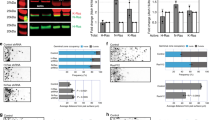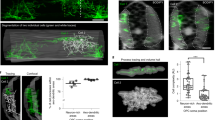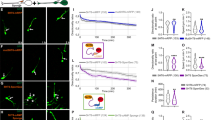Abstract
During their migration, cerebellar granule cells switch from a tangential to a radial mode of migration. We have previously demonstrated that this involves the transmembrane semaphorin Sema6A. We show here that plexin-A2 is the receptor that controls Sema6A function in migrating granule cells. In plexin-A2–deficient (Plxna2−/−) mice, which were generated by homologous recombination, many granule cells remained in the molecular layer, as we saw in Sema6a mutants. A similar phenotype was observed in mutant mice that were generated by mutagenesis with N-ethyl-N-nitrosourea and had a single amino-acid substitution in the semaphorin domain of plexin-A2. We found that this mutation abolished the ability of Sema6A to bind to plexin-A2. Mouse chimera studies further suggested that plexin-A2 acts in a cell-autonomous manner. We also provide genetic evidence for a ligand-receptor relationship between Sema6A and plexin-A2 in this system. Using time-lapse video microscopy, we found that centrosome-nucleus coupling and coordinated motility were strongly perturbed in Sema6a−/− and Plxna2−/− granule cells. This suggests that semaphorin-plexin signaling modulates cell migration by controlling centrosome positioning.
This is a preview of subscription content, access via your institution
Access options
Subscribe to this journal
Receive 12 print issues and online access
$209.00 per year
only $17.42 per issue
Buy this article
- Purchase on Springer Link
- Instant access to full article PDF
Prices may be subject to local taxes which are calculated during checkout








Similar content being viewed by others
References
Komuro, H. & Yacubova, E. Recent advances in cerebellar granule cell migration. Cell. Mol. Life Sci. 60, 1084–1098 (2003).
Zmuda, J.F. & Rivas, R.J. Actin filament disruption blocks cerebellar granule neurons at the unipolar stage of differentiation in vitro. J. Neurobiol. 43, 313–328 (2000).
Solecki, D.J., Model, L., Gaetz, J., Kapoor, T.M. & Hatten, M.E. Par6α signaling controls glial-guided neuronal migration. Nat. Neurosci. 7, 1195–1203 (2004).
Umeshima, H., Hirano, T. & Kengaku, M. Microtubule-based nuclear movement occurs independently of centrosome positioning in migrating neurons. Proc. Natl. Acad. Sci. USA 104, 16182–16187 (2007).
Kholmanskikh, S.S., Dobrin, J.S., Wynshaw-Boris, A., Letourneau, P.C. & Ross, M.E. Disregulated RhoGTPases and actin cytoskeleton contribute to the migration defect in Lis1-deficient neurons. J. Neurosci. 23, 8673–8681 (2003).
Guan, C.B., Xu, H.T., Jin, M., Yuan, X.B. & Poo, M.M. Long-range Ca2+ signaling from growth cone to soma mediates reversal of neuronal migration induced by slit-2. Cell 129, 385–395 (2007).
Kerjan, G. et al. The transmembrane semaphorin Sema6A controls cerebellar granule cell migration. Nat. Neurosci. 8, 1516–1524 (2005).
Tamagnone, L. et al. Plexins are a large family of receptors for transmembrane, secreted and GPI-anchored semaphorins in vertebrates. Cell 99, 71–80 (1999).
Toyofuku, T. et al. Guidance of myocardial patterning in cardiac development by Sema6D reverse signaling. Nat. Cell Biol. 6, 1204–1211 (2004).
Suto, F. et al. Plexin-a4 mediates axon-repulsive activities of both secreted and transmembrane semaphorins and plays roles in nerve fiber guidance. J. Neurosci. 25, 3628–3637 (2005).
Suto, F. et al. Interactions between plexin-A2, plexin-A4, and semaphorin 6A control lamina-restricted projection of hippocampal mossy fibers. Neuron 53, 535–547 (2007).
Weyer, A. & Schilling, K. Developmental and cell type–specific expression of the neuronal marker NeuN in the murine cerebellum. J. Neurosci. Res. 73, 400–409 (2003).
Sakagami, H., Umemiya, M., Kobayashi, T., Saito, S. & Kondo, H. Immunological evidence that the beta isoform of Ca2+/calmodulin-dependent protein kinase IV is a cerebellar granule cell–specific product of the CaM kinase IV gene. Eur. J. Neurosci. 11, 2531–2536 (1999).
Okabe, M., Ikawa, M., Kominami, K., Nakanishi, T. & Nishimune, Y. 'Green mice' as a source of ubiquitous green cells. FEBS Lett. 407, 313–319 (1997).
Sasaki, Y. et al. Fyn and Cdk5 mediate semaphorin-3A signaling, which is involved in regulation of dendrite orientation in cerebral cortex. Neuron 35, 907–920 (2002).
Bellion, A., Baudoin, J.P., Alvarez, C., Bornens, M. & Metin, C. Nucleokinesis in tangentially migrating neurons comprises two alternating phases: forward migration of the Golgi/centrosome associated with centrosome splitting and myosin contraction at the rear. J. Neurosci. 25, 5691–5699 (2005).
Schaar, B.T. & McConnell, S.K. Cytoskeletal coordination during neuronal migration. Proc. Natl. Acad. Sci. USA 102, 13652–13657 (2005).
Tsai, J.W., Bremner, K.H. & Vallee, R.B. Dual subcellular roles for LIS1 and dynein in radial neuronal migration in live brain tissue. Nat. Neurosci. 10, 970–979 (2007).
Higginbotham, H., Tanaka, T., Brinkman, B.C. & Gleeson, J.G. GSK3beta and PKCzeta function in centrosome localization and process stabilization during Slit-mediated neuronal repolarization. Mol. Cell. Neurosci. 32, 118–132 (2006).
Chedotal, A., Kerjan, G. & Moreau-Fauvarque, C. The brain within the tumor: new roles for axon guidance molecules in cancers. Cell Death Differ. 12, 1044–1056 (2005).
Ding, S., Luo, J.H. & Yuan, X.B. Semaphorin-3F attracts the growth cone of cerebellar granule cells through cGMP signaling pathway. Biochem. Biophys. Res. Commun. 356, 857–863 (2007).
Chen, G. et al. Semaphorin-3A guides radial migration of cortical neurons during development. Nat. Neurosci. 11, 36–44 (2007).
Tsai, L.H. & Gleeson, J.G. Nucleokinesis in neuronal migration. Neuron 46, 383–388 (2005).
Love, C.A. et al. The ligand-binding face of the semaphorins revealed by the high-resolution crystal structure of SEMA4D. Nat. Struct. Biol. 10, 843–848 (2003).
Bellenchi, G.C. et al. N-cofilin is associated with neuronal migration disorders and cell cycle control in the cerebral cortex. Genes Dev. 21, 2347–2357 (2007).
Rivas, R.J. & Hatten, M.E. Motility and cytoskeletal organization of migrating cerebellar granule neurons. J. Neurosci. 15, 981–989 (1995).
Gomes, E.R., Jani, S. & Gundersen, G.G. Nuclear movement regulated by Cdc42, MRCK, myosin and actin flow establishes MTOC polarization in migrating cells. Cell 121, 451–463 (2005).
Kholmanskikh, S.S. et al. Calcium-dependent interaction of Lis1 with IQGAP1 and Cdc42 promotes neuronal motility. Nat. Neurosci. 9, 50–57 (2006).
Tanaka, T. et al. Lis1 and doublecortin function with dynein to mediate coupling of the nucleus to the centrosome in neuronal migration. J. Cell Biol. 165, 709–721 (2004).
Jaffe, A.B. & Hall, A. Rho GTPases: biochemistry and biology. Annu. Rev. Cell Dev. Biol. 21, 247–269 (2005).
Rohm, B., Rahim, B., Kleiber, B., Hovatta, I. & Puschel, A.W. The semaphorin 3A receptor may directly regulate the activity of small GTPases. FEBS Lett. 486, 68–72 (2000).
Oinuma, I., Ishikawa, Y., Katoh, H. & Negishi, M. The Semaphorin 4D receptor plexin-B1 is a GTPase-activating protein for R-Ras. Science 305, 862–865 (2004).
Turner, L.J., Nicholls, S. & Hall, A. The activity of the plexin-A1 receptor is regulated by Rac. J. Biol. Chem. 279, 33199–33205 (2004).
Tong, Y. et al. Binding of Rac1, Rnd1 and RhoD to a novel Rho GTPase interaction motif destabilizes dimerization of the plexin-B1 effector domain. J. Biol. Chem. 282, 37215–37224 (2007).
Barberis, D. et al. p190 Rho-GTPase activating protein associates with plexins and it is required for semaphorin signaling. J. Cell Sci. 118, 4689–4700 (2005).
Toyofuku, T. et al. FARP2 triggers signals for Sema3A-mediated axonal repulsion. Nat. Neurosci. 8, 1712–1719 (2005).
Etienne-Manneville, S. & Hall, A. Integrin-mediated activation of Cdc42 controls cell polarity in migrating astrocytes through PKCzeta. Cell 106, 489–498 (2001).
Xie, Z., Samuels, B.A. & Tsai, L.H. Cyclin-dependent kinase 5 permits efficient cytoskeletal remodeling—a hypothesis on neuronal migration. Cereb. Cortex 16 Suppl 1, i64–i68 (2006).
Ohshima, T. et al. Migration defects of cdk5−/− neurons in the developing cerebellum is cell autonomous. J. Neurosci. 19, 6017–6026 (1999).
Xie, Z., Sanada, K., Samuels, B.A., Shih, H. & Tsai, L.H. Serine 732 phosphorylation of FAK by Cdk5 is important for microtubule organization, nuclear movement and neuronal migration. Cell 114, 469–482 (2003).
Kawauchi, T., Chihama, K., Nabeshima, Y. & Hoshino, M. Cdk5 phosphorylates and stabilizes p27kip1 contributing to actin organization and cortical neuronal migration. Nat. Cell Biol. 8, 17–26 (2006).
Clapcote, S.J. et al. Behavioral phenotypes of Disc1 missense mutations in mice. Neuron 54, 387–402 (2007).
Shu, T. et al. Ndel1 operates in a common pathway with LIS1 and cytoplasmic dynein to regulate cortical neuronal positioning. Neuron 44, 263–277 (2004).
Sasaki, S. et al. Complete loss of Ndel1 results in neuronal migration defects and early embryonic lethality. Mol. Cell. Biol. 25, 7812–7827 (2005).
Mah, S. et al. Identification of the semaphorin receptor PLXNA2 as a candidate for susceptibility to schizophrenia. Mol. Psychiatry 11, 471–478 (2006).
Takeshita, M. et al. Genetic examination of the PLXNA2 gene in Japanese and Chinese schizophrenics. Schizophr. Res. 99, 359–364 (2008).
Fujii, T. et al. Failure to confirm an association between the PLXNA2 gene and schizophrenia in a Japanese population. Prog. Neuropsychopharmacol. Biol. Psychiatry 31, 873–877 (2007).
Wray, N.R. et al. Anxiety and comorbid measures associated with PLXNA2. Arch. Gen. Psychiatry 64, 318–326 (2007).
Fatemi, S.H., Reutiman, T.J., Folsom, T.D. & Sidwell, R.W. The role of cerebellar genes in pathology of autism and schizophrenia. Cerebellum published online doi:10.1080/14734220701392969 (16 May 2007).
Marillat, V. et al. Spatiotemporal expression patterns of slit and robo genes in the rat brain. J. Comp. Neurol. 442, 130–155 (2002).
Acknowledgements
We thank H. Sakagami and H. Kondo for antibody to the β isoform of CaMKIV, M. Okabe for GFP transgenic mice, M. Bornens for centrin-GFP plasmid and antibodies to centrin, and L. Beverly-Staggs and L. Marquis for technical assistance with the NMF454 mice, the production of which was supported by the US National Institutes of Health (NS041215 and NS35900). We also thank Y.E. Jones and R. Robinson for their help with the analysis of plexin-A2 structure and R. Schwartzmann for help with confocal microscopy studies. A.C. and G.K. were supported by the Association pour la Recherche sur le Cancer, the Fondation pour la Recherche Médicale (programme équipe FRM) and the Agence Nationale pour la Recherche (ANR Neurosciences). H.F. was supported by the 21st Century Centers of Excellence Program and Grants-in-Aid for Scientific Research Japan. K.J.M. was supported by a Science Foundation Ireland grant (01/F.1/B006). S.L.A. is an investigator of the Howard Hughes Medical Institute. This work was also supported by grants from CREST (F.S.) of the Japanese Science and Technology Agency. J.R. is recipient of a fellowship from the Région Ile-de-France.
Author information
Authors and Affiliations
Contributions
J.R., G.K. and I.S. carried out the in vivo phenotypic analyses of knockout mice and the expression studies. J.R. performed the in vitro experiments. Y.Z. carried out the biochemical studies. C.F. generated the plexin-A2A396E construct and did the binding experiments. V.G. and J.R. performed the time-lapse microscopy and analyzed the confocal images. F.S. and H.F. obtained the Plxna2 knockout and antibodies. K.J.M. provided the Sema6a knockout and helped in the writing of the manuscript. D.K. and S.L.A. generated the NMF454 ENU-mutant and mapped the mutation to the Plxna2 locus. K.S. and M.S. generated the mouse chimeras. A.C. and H.F. designed the study, prepared the figures and wrote the core of the manuscript.
Corresponding author
Supplementary information
Supplementary Text and Figures
Supplementary Figures 1–5 (PDF 887 kb)
Supplementary Video 1
Time-lapse video 1 of migrating wild-type granule cells expressing centrin 1–GFP. The explant is on the left of the frame. (MOV 211 kb)
Supplementary Video 2
Time-lapse video 2 of migrating wild-type granule cells expressing centrin 1–GFP. The explant is on the left of the frame. (MOV 72 kb)
Supplementary Video 3
Time-lapse video 3 of migrating Plxna2−/− granule cells expressing centrin 1–GFP. The explant is on the left of the frame. (MOV 116 kb)
Supplementary Video 4
Time-lapse video 4 of migrating Plxna2−/− granule cells expressing centrin 1–GFP. The explant is on the left of the frame. (MOV 188 kb)
Supplementary Video 5
Time-lapse video 5 of migrating Sema6a−/− granule cells expressing centrin 1–GFP. The explant is on the left of the frame. (MOV 131 kb)
Supplementary Video 6
Time-lapse video 6 of migrating Sema6a−/− granule cells expressing centrin 1–GFP. The explant is on the left of the frame. (MOV 129 kb)
Rights and permissions
About this article
Cite this article
Renaud, J., Kerjan, G., Sumita, I. et al. Plexin-A2 and its ligand, Sema6A, control nucleus-centrosome coupling in migrating granule cells. Nat Neurosci 11, 440–449 (2008). https://doi.org/10.1038/nn2064
Received:
Accepted:
Published:
Issue Date:
DOI: https://doi.org/10.1038/nn2064
This article is cited by
-
Plexin-A2 enables the proliferation and the development of tumors from glioblastoma derived cells
Cell Death & Disease (2023)
-
Neuropilin 1 regulates bone marrow vascular regeneration and hematopoietic reconstitution
Nature Communications (2021)
-
Semaphorin 6A Attenuates the Migration Capability of Lung Cancer Cells via the NRF2/HMOX1 Axis
Scientific Reports (2019)
-
High-throughput three-dimensional chemotactic assays reveal steepness-dependent complexity in neuronal sensation to molecular gradients
Nature Communications (2018)
-
MARVELD1 depletion leads to dysfunction of motor and cognition via regulating glia-dependent neuronal migration during brain development
Cell Death & Disease (2018)



